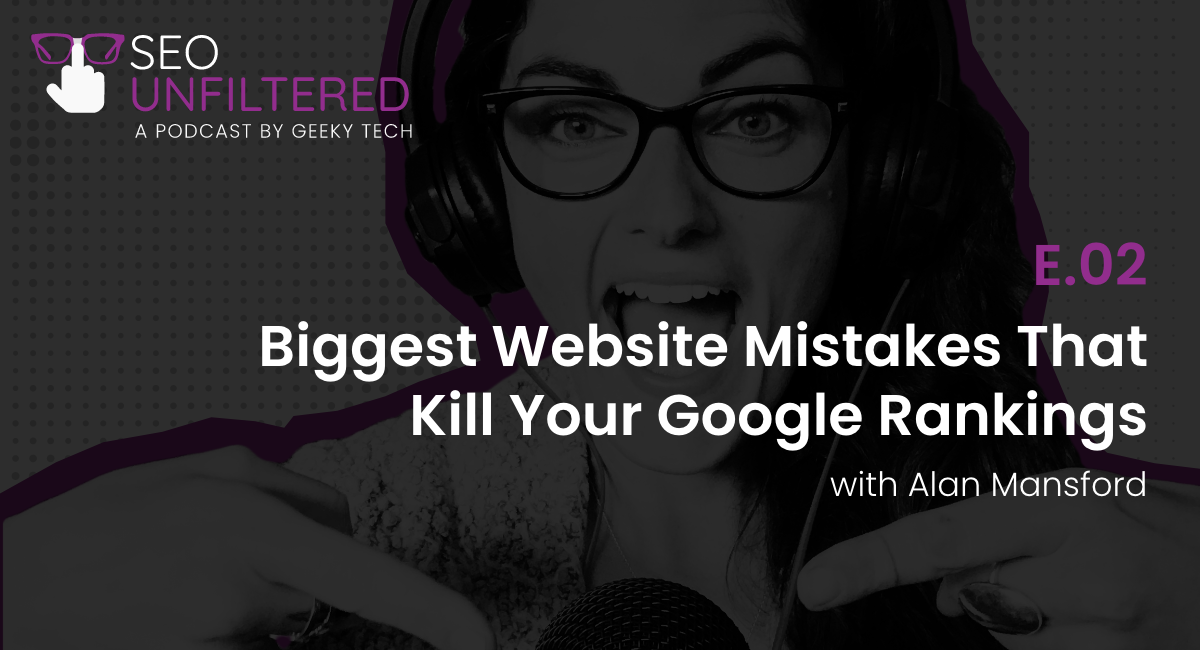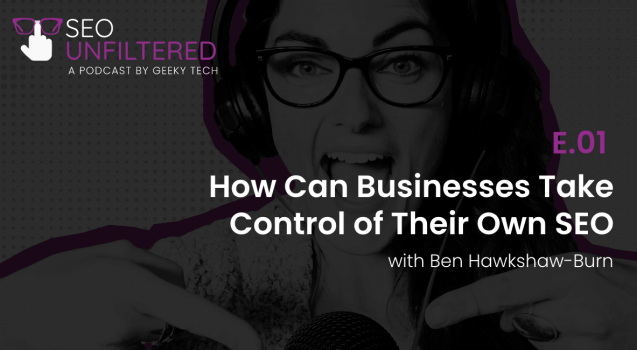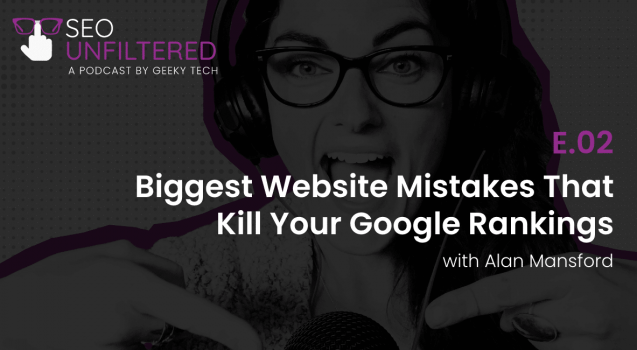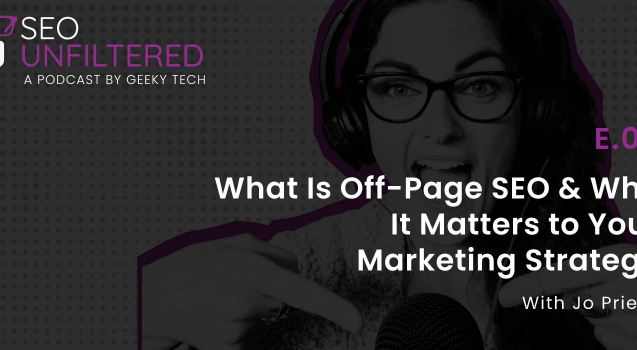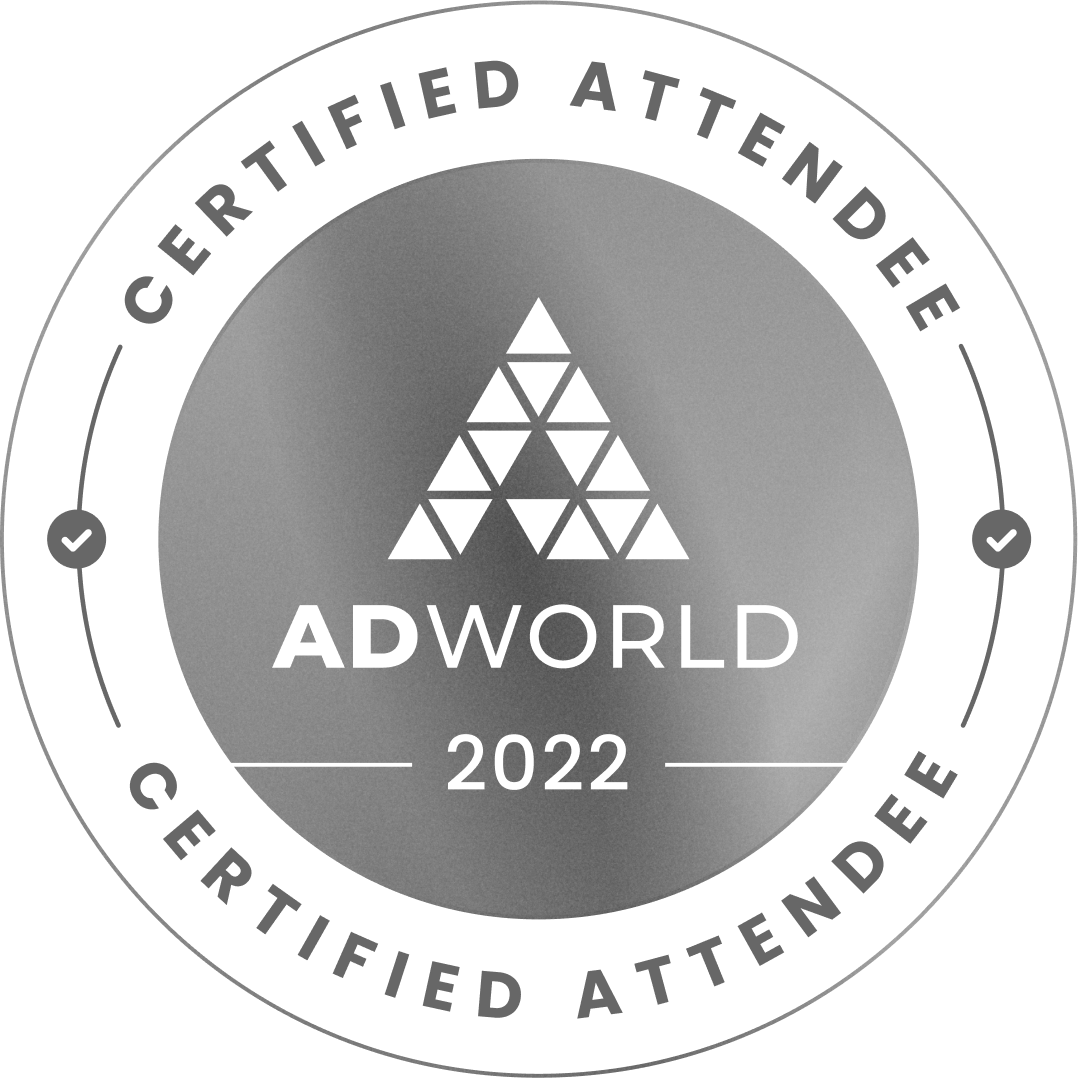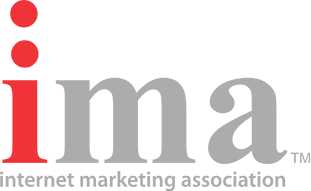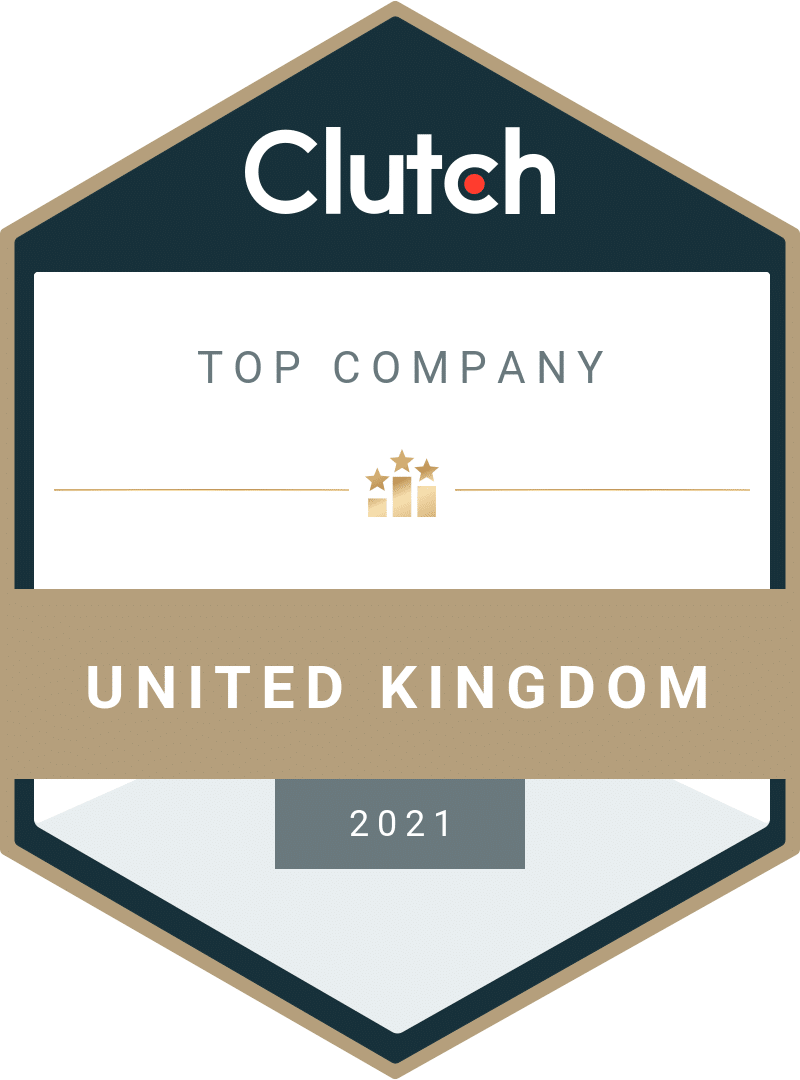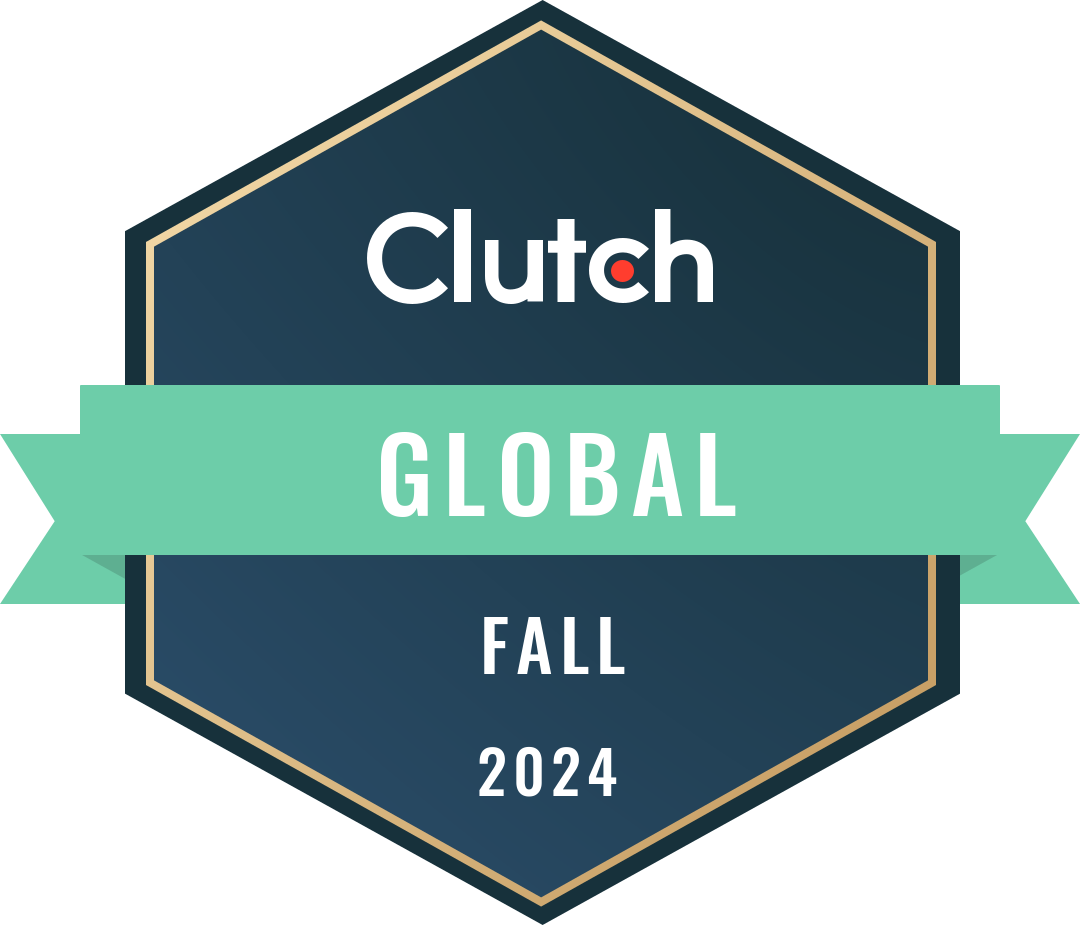Transcript
Genny: [00:00:00] What’s up marketing geeks. Welcome to season one episode two of SEO unfiltered. This is Jenny, your humble host and content writer for geeky tech, a UK based digital marketing agency. Today, we’re going to be diving into some of the biggest website mistakes I could possibly kill, or at least drastically lower your search engine rank.
And of course a website can be booted down the ranks for a variety of reasons, some of which aren’t mistakes at all, but flagrant violations of Google’s rules and regulations also known as black hat SEO. However, I maintain that there are plenty of people out there who use blackout SEO techniques with complete naivete.
So for the sake of this episode, I’m going to continue calling them mistakes. Of course, we’re also going to chat about the run of the mill innocent mistakes. Web managers tend to make. Last month, we explore the various ways that business owners can start taking control of their own SEO. So we thought this would be a sensible follow-up to that.
[00:01:00] Today. I am joined by SEO expert musician and fellow twin, Alan Mansford. Alan specialty is an on-page optimization, which he’ll tell you covers everything from technical SEO to UX. Hi, Alan. How’s it going?Alan: I’m good, Jenny, how are you?
Genny: I’m well, thank you. Thanks for joining me today. So let’s dive right into this with an easy question, which is do some SEO, mistakes carry more weight than others.
In other words, are there some SEO fo PAs that will instantly take you out of the running wall with others? It’s more like a slow erosion of rankings.
Alan: Yes. I wouldn’t say that. There’s a such thing as. All SEO, mistakes, caravan, equal weights. Uh, certainly things you can do that are worse than others. Uh, one good example of this is something called a no index tag.
So there’s a little line of code that you can put into each webpage, which tells Google or any search engine to either index or not to [00:02:00] index a page. You can not have that code. And a search engine will choose to index the page because that’s their whole job is to find webpages, crawl them and deliver them to people.
But if you accidentally tell them to not index the page, that is basically just a short. Okay. Any page that you wanted it, and we’ve had three instances in the last year from our customers who have mistakenly or inadvertently used no Indect tags by accident. No one does this on purpose. Um, so I won’t use names just to avoid customer embarrassments.
Um, but we’ve had one customer make changes to a staging site, which is basically, you know, like a, a sandbox or a version of their site that isn’t locked. Right. And then when they transfer. The staging site to the live environment as it’s called, they obviously just didn’t tick the right box and they know index their entire website.
Invisible. Yes, it doesn’t happen immediately. You have to wait [00:03:00] for the search engine to try and crawl the website again. And then when it, when it finds those tags, the no index tag, it says, oh, we’re not allowed to show this. So we weren’t. And then of course, a week later you see this graph in analytics, just this it’s not even a downward trend, it’s just a cliff, just go straight down.
And of course, then you realize what it is. You get in touch with them, tell them that it made a horrible mistake and they need to rectify it. Um, that’s the most extreme one. There’s other times where people have just accidentally index a few pages. They’ve never got an explanation that always say, don’t know how that happened.
Probably wasn’t me. He must have been one of the team. And then of course you, what you tend to do is you just change it from no index to index and then within a week or so typically sometimes sooner, it just depend on how. Google is calling your website. The more traffic you have, the more frequent it is.
And the other example was a customer who had an alternate [00:04:00] home. They basically want to rebrand their home page slightly or update the content. So they made two pages at homepage one, or that homepage and homepage. And I told them to no index homepage one until it was ready. Otherwise they’ve got two pages or two home pages available to Google, which makes no sense.
And then of course they didn’t let us know when they were making the change and going live. So then they deleted the old homepage, put homepage one as the homepage, which has a no index tag. So all of a sudden their home page is just not allowed to show in Google. And that was their, that was their main page.
That was. That bread and butter. So that is a no index tag is probably the best example of a severe mistake. No one does that on purpose. Um, something that people often do that is a slower, I think you said erosion of the rankings. Yeah. Making too many changes to pages that are performing well. Sometimes people have a rebrand or not even a rebrand, but it’s just want a new look to the website and they do one [00:05:00] new page and it’s got lots of nice white space and some fancy buttons, and they realize that all the other pages don’t look as nice as that.
So then they want to go back to the old pages. I make them all look coherent across the websites and they don’t tend to think about it from an SEO perspective. They might delete lots of content because they think less is more from a visual perspective. But if that page is already performing well, you’re better off just leaving it as it is for the most part.
So taking a page that’s performing well and continually tweaking it. What I call a folk
Genny: par. Okay. Do you have any other examples or can I ask you question number two?
Alan: Lots of other individuals amples but I’d say those two were the main ones that you see frequently across, across the board. The most customers
Genny: switch gears a little bit.
Can you explain to everyone listening what black hat SEO?
Alan: So, first of all, an explanation of the name, which is quite nice, black hat versus white hat is basically taken from Western. [00:06:00] Black hats were worn by the bad guys and white hat for the good guys. Right? So that is why there’s basically it’s it’s good versus evil is what we’re trying to imply here.
So white hat SEO is anything that is with. The guidelines of a search engine. So they acceptable practices and black hat SEO is a violation of those. So if you, if you want to, you can Google, well, you can Google Google’s webmaster guidelines, right. And they will tell you what they consider to be acceptable practice in terms of.
Manipulating a page to pay a higher in rankings and what also is not acceptable and anything that is outside of those guidelines is considered a black hat SEO.
Genny: Okay. All right. That’s simple enough. And so it’s not, when you say violation, cause earlier I said it’s a mistake, but it could be both right.
People could be making, uh, could be violating their rules and not even know it.
Alan: Definitely. I think again, with the SEO mistakes, it’s not a case of. Black [00:07:00] versus why there is definitely black hat tactics, or white hat tactics, and there’s certainly gray. And that could be from the point of view of ignorance, like someone is doing black hat tactics, but they’re not aware of it.
It’s not quite the same thing as purposefully using those tactics year on
Genny: year. Okay. Good to know. And just to set the record straight, what are the risks of using black hat tactics? Is it illegal?
Alan: Yes. I think it’s six months in prison, UK. No extradition. Wow. That’s harsh. I know it’s not illegal. There’s no jail time.
Uh, the, the risks involved are basically undoing what you want when you, everyone does SEO in order to get more traffic and more leads. Right. And you run the risk of being penalized by Google, either lower in the rankings or taken out of the rankings and Tylee, which of course would mean you get no organized.
Genny: Would you be able to run a brand new website if Google knows that you have violated their [00:08:00] terms and conditions
Alan: before it is S it’s associated to the domain? Typically, if it is a new website, so it’s not, you personally, they won’t know that they won’t know that. Did it. Okay. So we’re going to be associated via email addresses.
So you log into your email. The question really would be is can you continue with the same website and you can, but you have to basically, depending on what you’ve been penalized for, if it’s bad, badly, You would need to disavow those links. Uh, if you’ve been, if you had a malicious SEO attack on you, sometimes you just need to let Google know that there’s various ways of doing this, but most of the time you need to just stop, stop doing what you’re doing immediately, and probably leave a few months until the dust settles.
Genny: But I can also see that being devastating to your business. You just have to not have a web presence for that time and that. Ruin things for it. Yeah. [00:09:00]
Alan: I would say though, that it’s unlikely that you are doing the kind of black hat tactics that would get you penalized without knowing it. Although there are some gray areas.
I think if it’s, if it’s severe enough for you to be penalized and taken out of rankings entirely, you’re doing something that you’re probably aware of. Or I guess the other example would be that your SEO team or your digital marketing team is doing something on your behalf that they know is.
Genny: And I guess the one black hat tactic that I can see people possibly doing out of ignorance maybe is keyword stuff.
So what exactly is that and how bad
Alan: is it? So keyword stuffing is including your target keyword, wherever you’ve chosen, basically as many times as possible in order to increase the density of the keywords across the, across the whole page. And what that ends up doing is making the page and the language used really unnatural.
So even the keyword density is actually a very [00:10:00] important part of her ranking. Uh, audit, um, there’s no point having a piece of content that people can’t read or is not as good as your competitors. Cause they’ve got a good content writer and done it in a more natural way.
Genny: Right? Okay. So what’s the rule of thumb.
How many times, or what percentage of copies should we be using for our keywords?
Alan: It’s a very good question. So what I would do, if I’m optimizing a page for a keyword, what I would do is I would just search that keyword in. And look at the SERP, the search engine results page. And then I would actually look at, say the top three to five results and see what their density is like for that target keyword.
And it isn’t the same across the board. If sometimes you might have a piece of content that has an 8%. Um, density on that type of chemo, which is quite a natural and it doesn’t read very well, but they’re still doing well. And other times it might be 1%. So what I would tend to do is I would just look for the upper and lower bounds of those results and try to work within those parameters [00:11:00] may, can be anywhere from one to 8%, but you do want to recognize that if you’re comparing yourself to a piece of content that isn’t like.
So if you’re doing a P a 2000 piece, 2000 word piece on whatever your services is, and one of the pieces in Google is actually a best of, you know, the 10 best. Things in 2022 that end up having very repetitive content, but in a fairly natural way, because it’s not trying to be coherent. So you wouldn’t want to compare yourself to articles like that.
You’d want to find a like for like, but there’s no, there’s no magic number. And if, if you’re gonna make me, if you’re gonna make me, I’m going to say three, right. 3%,
Genny: it’s a magic number. Um, okay. So the next. Black hat tactic that might be, or maybe it’s not black hat. Um, but a mistake is keyword cannibalization.
Um, would you care to explain what
Alan: that is? Sure. Yes. It’s definitely not [00:12:00] a black kind of thing. It’s just a mistake. There’s there’s there’s no. There’s no potential benefit to cannibalizing keywords. So obviously it comes from the words, cannibal first, the idea that your keywords or your pages are eating into each other’s space in Google.
So you’ve got, if you have two pages on your site that are competing with each other to appear for the same term in Google. So if we just want it to pick essence, we will, since we’re a geeky tech, if you had a two pages around. The geeky tech podcast, and they’re very similar. Google doesn’t know which one to show, and that is the problem.
You want to be very clear on what you want to show search engines. And as soon as you give them two options, you might end up having one day, a page, a showing a one day page be showing. And the reality is you end up having sometimes two URLs in the list. But lower down. And as soon as you saw that, as soon as you amalgamate or consolidate the content, you end up [00:13:00] having one page showing higher up.
So that’s, that’s typically it.
Genny: And so when you’re doing a site review, do you check for a keyword cannibalization?
Alan: Not typically on a site audit because it’s a page level issue rather than a website issue. Having said that. Sometimes what happens is people when they’re creating new pages is they copy old pages and they’ll duplicate an existing page that they like to look off.
And then they’ll repopulate it with new content, but they don’t go and change everything. So you might have the title, the method title, for example, what shows up in Google that might end up being the same as the previous page and that wouldn’t in of itself create cannibalization, but it could contribute to it.
So when I’m all the thing of sites. I would go and fix those things. So I could inadvertently fix some cannibalization issues, but it’s one I’m looking at actually optimizing pages themselves that I would check for that rather than the whole website that comes
Genny: later.
Alan: Right. [00:14:00] For us. Yes, it does.
Genny: So let’s move on to cloaking, which may sound very dark and mysterious, but it’s actually
Alan: what, well, it actually is fairly dark and mysterious. Um, so cloaking is when you’re, when you present different content to the user than you do to a search engine. So there’s different things. And the webpage, which it tell you what kind of person is a person or what device you’re using, whether it’s a web crawler.
If it’s a search engine, who’s visiting the page. And you could specify that when Google bot visits that page, it is shown that this content and when a human visits, the page they’re showing something completely different. Now this is so that’s out of the you’re cloaking, the page, you know, Google, Google sees one.
Or being sees one thing and the user see the other. So the idea is that you might have a brilliant SEO page, 10,000 words, [00:15:00] keyword stuffed everywhere. Show that to Google. But of course, if a human saw that they think that it’s terrible, I don’t want to say it. So you show the humans a nice pretty page, but which Google has ranked highly because of the Patriots or how do
Genny: you do that?
I’m not trying to give people tips.
Alan: This is. As they come, basically, because it’s complete, it’s complete manipulation of not only webmaster guidelines, but also the user. Just the idea that Google is serving a page that the user won’t see. So there’s a disconnect there. And this is, again, this is something that you would never do by accident.
You couldn’t sit and go, oh, am I serving a different page? You’d have to have someone typically an SEO team or a server service side technician at that time. Do you see that often? No. I mean, you hear about it. People have customers of ours. For example, if you’ve hired an SEO team, it’s because they haven’t got the technical knowledge to do the SEO themselves.
So you [00:16:00] typically onboard a customer who has a cloaking issue, but you, but you might, you tend to hear about it from tech, in testing environments or testing communities and the old sort of anecdotal nightmare story about panelization from Google. It’s not something that I personally have seen with any frequency at all.
Okay.
Genny: Okay. So that is kind of dark and mysterious and evil almost. So I keep bringing up black hat SEO. I think the most that that most of our listeners are probably not participating in the dark arts. So having said that, is there any other black hat, SEO tactic? That’s an easy mistake to make that someone could be doing and not even knowing it’s against Google’s rules.
Alan: Yeah, I think buying links is probably a good gray area cause people do it. And even using PBN networks or private blog networks is according to the letter of the law, black hat, but it’s kind of accepted because [00:17:00] the website, so, you know, Internet’s everywhere and there are authoritative sites that have space.
I want to make money, but I think it’s, it’s a case of people doing it sort of flagrantly and maybe a pairing insights that they have no place I’ve been linked to from sites that they probably shouldn’t do because it’s not relevant. And the best thing you can do is if you’re buying links is to try and have some control over.
So you, don’t the reason you don’t want to just buy a link from an advert you saw on the internet is because you have no control over it. If it turns out buying that link actually gives you a penalty for some reason, because maybe this, maybe the site you bought a link from is spammy and it doesn’t carry the sort of the authority and the weight that you wanted it to.
You. Haven’t got the control to go in. So that’s part of the public buying links. So you’re not actually in control. You may have just spent good money on something that could potentially do harm, which is [00:18:00] it’s not necessarily going to happen straight away, but you want the ability to not only remove the link, but perhaps change the link if you use exact match anchor.
So say you wanted to rank geeky tech for SEO podcast, and you would using SEO podcasts as the anchor text. And then for whatever reason, That wasn’t a good idea. And you decided to change your mind and you just want to use a branded term. So just, you know, Kiki tech or a naked URL, you would have the ability to do that.
If it was a link that you were in control of, but when you buy links off the internet for people you don’t know, you’re basically at their mercy. Yeah. So that is a good example of something that people are very well aware of and you can, anyone can go and buy links, but it is technically black hat, even though it’s quite quite prevalent.
Genny: And you mentioned something earlier, uh, this word disavow, does that have something to do with it if you don’t want that link
Alan: anymore? I guess you could. Yes. Even though you paid for it, it’s basically just the ability [00:19:00] to via Google as a disavow tool to basically just cut ties with this battling. Okay,
Genny: but then again, you
Alan: already paid for it.
So hopefully, hopefully you’re not disavowing links you paid for. Yeah.
Genny: Okay. So we have keyword stuffing, page cannibalization, black hat magic. And so what’s next? How about we talk a little bit about, um, maybe user experience or UX. Can you explain what that is?
Alan: Yeah. Uh, so it is literally kind of what the name says.
It’s the idea that the UX is how the user experiences your page. So regardless of thinking about SEO or how crawlers look at your site, when you log on to. How’s your experience does, does it look nice? Does it load fast? Are there is the information good when you’re going to ask me, but it’s a ranking factor on you.
One of those things, that’s where, where they’re going. Um, so typically speaking, I would say [00:20:00] really bad UX is a ranking factor. If it’s bad enough to reach whatever the threshold is. So everything in Google is mobile is mobile. So index is the mobile version, which basically is missing. It’s not actually on iOS or Android.
It just means particular screen width is how the content needs to be shown. And that version is what Google looks at first. If for whatever reason, you’ve made a beautiful page on a desktop. And then when you, when you shrink the screen or the text is overlapping each other, the images don’t show, and you can test this quite easily using the Google mobile friendly test.
If you don’t pass that, then you’re likely to suffer in the rankings, but that’s fairly hard to do with modern websites. And if you’re using WordPress or any other website builders such as Wix or Squarespace, or even HubSpot, all the, to a [00:21:00] dynamic flexibility of a website is pretty much done for you that there are the occasional issue, but 99% of it is done out of the box.
Right? That means you’re going to pass that test. The next step is if your UX is bad enough to stop your users converting. So there’s nothing to do with. We’ve had issues where people have had websites and we ranked them number one on Google for the term they’ve chose, but their website doesn’t look very good.
And they say, oh, we’re getting a hundred percent increase in traffic, but no, one’s converting and that’s not technically SEO, but obviously people don’t just pay for SEO to get traffic. They actually want leads to generate revenue for their business. So that’s where is it? A blurred line there. If you see what I mean, it’s not technically SEO, but it’s something that you would want to look into because we don’t want to invest resources on ranking their page and then no one, and it basically not deliver for the customer even though it’s top of group.
[00:22:00] Right? So it’s a ranking factor if it’s really, really bad, which is fairly rare, but other than nice, it’s not a ranking factor, but it will affect. Your conversion rate.Genny: Okay. I think what, cause when I was interviewing Ben last month, he said that user experience isn’t really an SEO ranking factor. So maybe that’s why he said it’s because it’s kind of a blurred line or it has to be extreme.
Alan: Okay.
Genny: So Alan, what’s one of the biggest UX mistakes you see most
Alan: often it would just be not considering the mobile display. So you can have things where. Sometimes tables. If you, if you want to compare your product versus competitive products, people often use tables to display that data and they are notoriously difficult to display on mobile because it’s not a case where you just shrink it.
So they’re often something that don’t show up. Some people who have huge images above the fold. Some people just [00:23:00] like that. I don’t, but that’s, that’s nothing to do. SEO. That’s just look into my brain. Um, and then also not given the user opportunities to either click through, to relate to content or actually convert.
So not necessarily on mobile, because you have limited space in comparison to a desktop, but on a desktop, if you’re looking at a whole page, you want something. Whether it’s the, whatever the intended target is. If it’s the contact us page, cause you feel that this is a, a services page and the next step for the user is to get in touch with you and spend their money.
Then you need to give them the opportunity to do that. If you’re talking, if you’ve got a paragraph about a topic that you have written other content about, you want to make sure there’s a link in there which clearly explains read more about what. But people, people just don’t do this. You could have thousands upon thousands of words of content, and it’s just big [00:24:00] blocks of text and there’s nothing, but there’s no opportunity for people to move or continue their journey.
And also even just links in that short text, make, make something stand out. It just looks visually more appealing to have things going on on the page. Yeah, that’s probably the biggest UX mistake. Just not actually making it nice to look at.
Genny: I see that, uh, accessibility can maybe lower rankings or lack thereof
Alan: as far as I know, not yet.
Um, so people are aware. Accessibility is for users who are visually impaired or don’t have the ability to use a computer or view a screen in the same way that everybody else. So it can be people using a screen reader, which I’ve never actually done. Okay. But that’s, that’s one of the reasons that’s the primary reason.
In fact, while we have alt tags, so a little tag within the niche. So when the image can’t be shown, the alt tag is [00:25:00] red to the user, which is why, if you have an alt tag, which just says photo rather than a beautiful sunset. Paris. Um, then the idea is you, you can use them to actually, you know, if you’re, if you’re trying to rank a piece around Paris and that’s what you say, you put the word Paris in there, but the whole, the primary reason of them it’ll actually read to a user, what they’re meant to be seeing if they’re unable to, or the issues are font size being too small.
So if you have, if you’re visually impaired, I think 16 pixels. Acceptable minimum, uh, and then forms as well. If you have forms that are confusing. So sometimes people have placeholders in the form. So it’ll say in the, in the form field, it will say name and when you click on it, name will disappear and whether you type overwrites it, but that can be a little bit confusing to people who aren’t maybe familiar with using [00:26:00] forms.
So it’s better to use. Titles or labels or both the form to tell people what they meant to him. But now, from what I understand in America, if you have a copy of what it is now, but the equivalent of a.gov site, then you can begin to get penalized. Or this is something that they’re aware. I think that would be because they’re official government sites, but typically speaking, anything that happens there will probably filter down into the main.
In the next five to 10 years, but currently I don’t think it’s something that you need to pay attention to specifically for rankings. But having said that why you make, why are you making it harder for users, even if you’ve got great eyesight and you understand how to use a computer, you want to be able to read the text and understand the forms, et cetera, et cetera.
So you may as well just do a good job for.
Genny: Yeah, I agree. Okay. So let’s move on to technical SEO. Can you explain what that is? Because I know that there are just so many nitty gritty details you look [00:27:00] for when you’re performing a site audit, but maybe, maybe you could give us like a little, a little hint, a little tidbit, or a general idea
Alan: of it.
I actually had to Google what technical SEO meant, because I’m yet to find a good explanation in my experience because I’m the person doing the audits and the optimizations technical means. The person you’re talking to. Doesn’t understand. So
if I’m talking to a customer who’s never heard of SEO, everything is technical SEO. If I’m talking to someone who knows what they’re talking about, then there’s less, it’s something else. Yeah. I use technical SEO to mean, listen, customer, you don’t know. This, but we do because we’re the technical SEO experts.
I don’t know exactly what falls into S uh, technical SEO, and non-technical typically speaking the white hat stuff. So stuff to do with on the page, in terms of the content, the actual copy written isn’t considered [00:28:00] technical, anything considering crawling. So how, uh, orphaned pages and how, you know, what’s, what pages are accessible and anything, I guess, with like metadata.
It’s probably considered technical SEO, but I’d love, I’d love to know what the official explanation is because I read three or four and they weren’t the same,
Genny: uh, in my mind, I thought it was everything that had to do with the backend.
Alan: Maybe it could be because then if you go into the backend or something like Wix, it’s not, it’s not for technical.
That is true. I would say anything to do with crawling and shit. We’d probably be considered technical. Cause they’re often terms that people think, oh, we need to hire an SEO agency for that. Cause that sounds really technical. Okay.
Genny: Okay. But I’m sure you must get this a lot where a marketer thinks they know how to fix something and then they just end up breaking it.
And so you have to go in and take a look at there’s [00:29:00] schema
Alan: and see what they do. Examples I gave right at the top of this podcast with the no index tags is the perfect example. People go. Taking a button because they think they’re meant to, and it has catastrophic results. Um, schema, typically speaking, you don’t tend to do it wrong.
It’s not a case where if you do it wrong, it’s going to harm you, but it’s the case that you just want it done. Right. So I will always write schema from scratch rather than using any, any presets in plugins, et cetera. Um, some people I’m yet to actually find a website from scratch that. Bothered to do it correctly because it’s probably ignorance.
They wouldn’t know how or why they need to. So I would certainly put those two you’re crawling, you’re using a crueler such as, um, screaming, frog or sight bulb. So he’s, uh, he’s a third party crawlers, which basically just search your site like Google would and show you what’s displayed. Um, is there anything to do with those tools and schema?
I would definitely [00:30:00] classify as technical SEO.
Genny: So, Alan, what is the most annoying technical SEO mistake you’ve encountered
Alan: or annoying?
Genny: Yeah. In your, in your personal opinion, what’s super annoying.
Alan: Probably two things. So it would be a lot of unnecessary redirects. So one would be a redirect is basically when you try and visit a page. So say you want to go to geeky tech.co.uk for slash page a.
And when you click on it, you get taken somewhere. Now. Okay. That’s not a bad thing necessarily if you pay, if you built payday and it turns out you hate it and you built page B and you redirect it firm page a to page B, that is absolutely fine. But it’s when you go from page to page B to page C to page.
That is really confusing for search engines. It doesn’t know. Do people do that? Not a, B and C and D no, but they do have redirect that’s, what’s called a redirect [00:31:00] chain and it’s just considered bad for technical SEO. So what you would do if you were going from page a, to B, to C, to D you would remove the middle to redirects and you would just redirect page a to page D and cut out the middle of it.
Right because you never going to get ascites unless it’s brand new, really? That has no redirects, which people do just change content, want to archive content and move links from one place to another base when people don’t do their housekeeping. I think that is when you’ve got this 500 page on a website.
No one knows who built it or. Maybe it was the previous marketing manager from five years ago. That’s when you get quite messy sites and the other, it’s not really a pet peeve or an annoyance, but having 500 pages on a website. And when you crawl the website to see what pages are available, you only find 20, which means that the remainder of them are what’s called orphaned.[00:32:00]
There’s nowhere to link to them from the home page. So the idea is if you have. A hundred pages on your website. Most of those pages or the, at least the important pages of the website need to be accessible from the homepage. Or a crawl depth as it’s called of too. So say you’re on the homepage, you click it to another page, the services page, and then you list out all your 20 top services that you provide to your customers.
Those pages are two clicks away from your home page and that’s where you want most of your home or your services pages, your important SEO pages to be. If you start getting, if you’ve got to click six different links to get to the page, it basically means. People probably aren’t going to do that, or it’s less and less likely with every step.
And if you can’t find it at all, that’s what you refer to as an orphaned page. There’s no, there’s no connection to it, to the rest of the website. And it’s not, it doesn’t mean that you can’t do well, that you will typically provide. [00:33:00] To Google or to bank listing all the pages that you want to show in search, but having links from the home page, linking to that page, help with the link equity or the SEO juice that people say, do we have a preferred term for that?
I think, I think Ben has said SEO juice, juice. So that’s, that’s why you would do it rather than just holding a site map. You want the homepage to pass a little bit of juice onto the services page and the service page as passes a little bit more juice onto each individual service page.
Genny: So in that, in your professional opinion as best
Alan: practices yeah.
Where possible is we’ve got customers, you’ve got brand new websites and they’ve got 25 pages and it’s really easy to do. On 25 pages. When you inherit a customer’s website with 500 pages, this is very, very difficult because you can’t necessarily be, there’s not necessarily one fix to do that. So you literally have to prioritize by.
This [00:34:00] page is going to rank for this keyword that we’ve identified. And that’s really important to the customer. Therefore it’s important to us and that’s what we’re going to try and fix. So I would typically try and always fix that on a page by page basis when optimizing it. It’s just very hard to fix for the whole website.
In one fell swoop.
Genny: Okay. And so someone sees that there are mistakes on their website and they make the necessary changes. How long can they expect it to affect their rankings in a good way?
Alan: Completely depends on what you’ve done. Um, a lot of the technical SEO stuff that you do is often a bit of housekeeping and it’ll, it will help the whole site as a whole.
Be crawlable and be indexed and re crawled more regularly. Um, it doesn’t necessarily help with individual rankings. It might too, but I don’t think there’s any hard and fast rules. If I order a whole website, I don’t necessarily expect that one page to improve. I hope I spent the whole [00:35:00] website to improve increment incrementally.
And then you would pay particular attention to the important pages.
Genny: Okay. You might’ve actually already said this, but for the first example you gave about, um, index, no index, once you actually turn on the indexing, I guess you could say, how long does it take for that to, for Google’s actually. Start, uh, crawl your web site.
Sorry. I’m not,
Alan: it’s a good question. And there’s no correct answer right now. Indexing in general is really slow. So compared to, you know, years gone by, you’re having to wait sometimes weeks where it would have been days before for them to recognize and actually show in their index. It is partly dependent for the recording, your website as to how much traffic you get.
If you’re, if you’re a yes, if you’re a big website and you’ll get in at 5,000 views a day, it makes sense for Google to be recalling it because a big proportion, a bigger proportion of its users [00:36:00] are experiencing your website via search engine. If you’re a new episode, you’ll get in 20 users a month.
There’s not much reason for Google to waste its resources to call you. Okay. So hopefully as you improve your SEO and improve the traffic, the, the frequency of the re crawling should improve. So
Genny: Alan, someone listening to this episode has realized that they’ve made a ton of mistakes on their website and they want them fixed as soon as possible.
What can they do?
Alan: Well, you can obviously just read your SEO blogs, listen to the SEO and filter podcast. Take whatever information you can and have a go at it. But there are certain things where a little bit of knowledge is a dangerous thing, and you are probably better off talking to an agency or talking to a professional about if you’ve got an idea of what the problem is, maybe they could help you out.
Having said that you might have a bunch of problems that you don’t even know about. Um, [00:37:00] typically speaking on a page by page basis, people. Feel empowered to try and give things a go don’t try and change your highest performing page. If you’ve got 10 pages that bring in traffic and the other 90, don’t feel free to muck around with the other 90 to see if you can improve them.
Don’t just try out some way to experiment on the page though, already providing you the S the organic traffic, anything with a more of a site wide. Or an audit on all pages? I would probably be just Trent on the side of caution.
Genny: Okay. Okay. Fair enough. Well, there you have at tech marketers, while it sounds like it’s easy to make a mistake and lower your rankings, a little bit of knowledge goes a long way, but also as you just said, it can be a dangerous thing.
So if you’re not sure that what you’re doing will help or hinder your website, start with common sense. And if you’re still not sure, you could probably find the answer to your question online. Obviously you can also reach out to an SEO expert like Alan, who will [00:38:00] not only run your site through a thorough on page checklist, but who will also sit down with you and make sure you understand what the heck is going on with your site.
Having said all that, Alan, is there anything more you would like to add,
Alan: please? Like, and subscribe because I have, I have.
Genny: Oh, well it’s cause you want to hear your own voice?
Alan: Isn’t it. I subscribed, I get a five star review after I heard the last episode.
Genny: Okay, perfect. And listeners, if you want to know more about on-page optimization and how to boost your rankings, we are going to leave a ton of resources for you on the show notes, as well as the episode transcripts.
The transcript for your reading pleasure and stay tuned next month for episode three, I don’t have a guest lineup just yet, but I have a funny feeling that it’s going to be with my good friend, Joe priest, who is the king of topical relevance. So stay tuned for more details about that. Don’t forget to follow us on Twitter, Facebook, Instagram at geeks for all things, SEO and advertising related and subscribe like, and follow us on apple podcast, [00:39:00] Spotify, Google podcasts, or wherever you listen to your favorite shows.
That’s it for now. Peace out marketing geeks.
Show Notes
What’s up, tech marketers? We are already at episode two of this ragtag SEO podcast, and we are feeling great. Last month, we learned how marketers (such as yourself) can take more control of their website’s SEO. And this month, we just assumed everyone listening heeded our advice and took full control of their website with all the passion and alacrity of a baby who just learned how to walk.
But before you start pressing buttons, pulling levers, and just generally being a smart alec, you should probably know that when it comes to SEO, a little bit of knowledge is a dangerous thing. So, stop what you’re doing, and listen to episode two before you break your website, because today, we’re going to be diving into some of the biggest website mistakes that might be lowering your rankings.
And who better to discuss this subject than Alan Mansford, an on-page SEO wizard who makes a living fixing and optimising technology websites?
Alan and I dive right into the biggest mistakes he sees over and over again and he spends plenty of time cautioning us about the evils of search engine manipulation, otherwise known as black hat SEO (spoooooooooky).
If you want to know more about SEO, check out the following links:
Did you miss our last episode? You can previous episodes, transcripts, and show notes on our official SEO Unfiltered Podcast web page. Don’t forget to follow us on Instagram, Facebook, and Twitter @GeekyTechGeeks for all things SEO and advertising related. And lastly listeners, just a small favour: if you like what you heard today, be sure to subscribe, like, and follow us on Apple Podcasts, Spotify, or wherever you listen to your favourite shows.
Want to hear more SEO Unfiltered? Stay tuned for episode two (airing in March), where I sit down with on-page SEO wizard Alan Mansford as he walks me through the silliest website mistakes that both slowly and quickly kill your website rankings.

